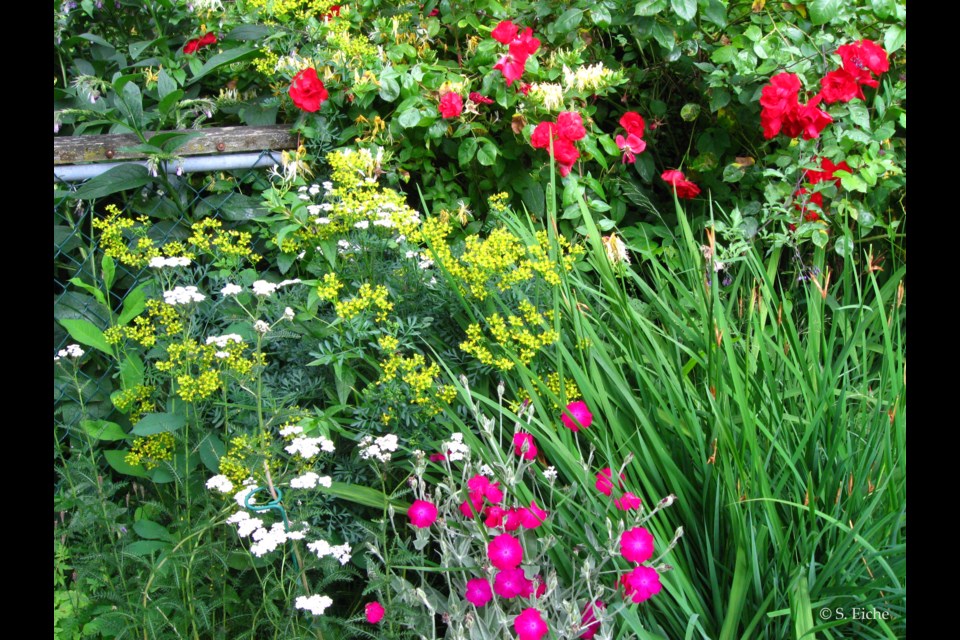I first noticed it when I tried to evict long stalks of grass growing among the flowering plants.
They were taunting me with their plumes waving in the breeze. I pushed my hand down as far as it would go into the foliage and yanked.
The stalks of grass came away, but my success didn’t feel like much of a victory when I saw what I’d caused. The once beautifully arranged composition (not a leaf out of place) now looked as if a thoughtless creature (me, I’m afraid) had ploughed through it. I had disturbed a natural harmony.
Since then, I practice restraint. If the taunting of the grasses is unbearable, I limit myself to cutting off the plumes that have pushed out of the mounds of flowering plants.
I have learned to be patient because I know that, come winter, when the plants have retired, I can target the grasses directly. I can dig them up by the root and hopefully disturb them totally and completely.
First documented in English in 1268, disturb comes from the Latin turbare, meaning to throw into disorder, preceded by the prefix dis, meaning utterly. Turbid is another English word from that source; also the more modern turbine (1838) and turbo (as in turboprop, turbojet, both 1945).
There’s a lot of disturbance going on everywhere. Sometimes, often in fact, the results are better if we refrain from disturbing. This is especially true with regard to the current youngest generation.
Children are suffering because their natural tendencies to play, romp, explore, investigate, imagine et cetera are being hampered – by too much screen time as well as overprotective adults.
It’s alarming that disturbances seem to be happening with increasing frequency.
For just a few that surprised and perturbed me, see Patrick Greenfield’s article reporting on various ways in which wildlife has had to evolve in order to survive because of the disturbances we’ve caused.
Here in Richmond, we can experience firsthand the benefits of a do-not-disturb attitude towards nature.
Three years ago, a plot of ground at the back of Richmond Secondary was prepared for the planting of the first Miyawaki, or mini-forest, in this part of Canada.
It was a collaboration between the Garden City Conservation Society and Richmond Secondary School, funded by a Tree Canada grant.
Following the method developed by Akira Miyawaki, plants that are native to the area grow to become a multi-layered forest.
One important consequence of planting according to Miyawaki’s teaching is that after the first two years, the vegetation takes care of itself. We do not have to disturb the mini-forest. It becomes the realm of wildlife.
Richmond’s first Miyawaki forest started out as they all do – an expanse of very small plants peeking out of ground covered with straw and mulch. That was in November 2022.
It was hard to imagine what it would look like in a couple of years. And anyone who sees that mini-forest today will find it hard to imagine what it looked like when it was first created.
Since then, several more Miyawaki forests have sprung up in Richmond – two at Terra Nova in April and October 2023, one in Garden City Park in March 2024, and another on the Garden City Lands in October and November 2024.
In May of this year, the sixth Miyawaki was planted at Spul’u’kwuks Elementary School – it consists of 476 native plants set into the ground by hundreds of students.
A seventh Miyawaki forest is scheduled for September.
We humans have a tendency to meddle, interfere and disturb.
Occasionally, that’s beneficial. But sometimes it’s better to let things – whatever they are – find their own space and move at their own pace. To just let them be.
Sabine Eiche is a local writer and art historian with a PhD from Princeton University. Her passions are writing for children and protecting nature. Her columns deal with a broad range of topics and often include etymology in order to shed extra light on the subject.
📣 Got an opinion on this story or any others in Richmond? Send us a letter or email your thoughts or story tips to [email protected].
📲 To stay updated on Richmond news, sign up for our daily headline newsletter.
💬 Words missing in article? Your adblocker might be preventing hyperlinked text from appearing.

.jpg;w=120;h=80;mode=crop)

